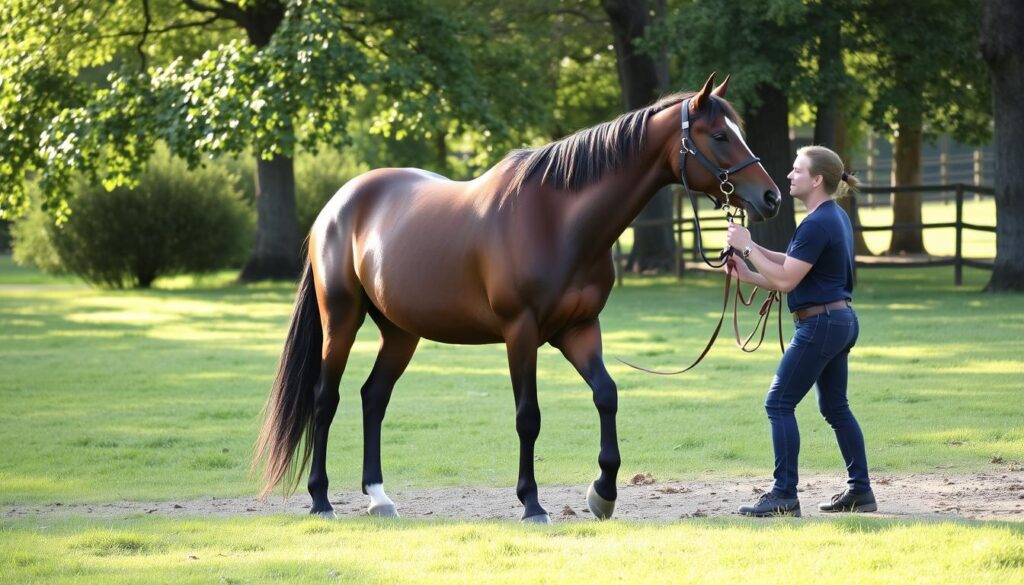Horse groundwork for beginners is an exciting journey that lays the foundation for a strong connection with your horse. By understanding horse behavior and psychology, you can create a safe and positive environment for training, making the process enjoyable and rewarding.
Groundwork exercises are done while leading the horse. They help horses trust and communicate better. This makes training fun and easy.
We will cover the basics of horse groundwork for beginners. We’ll talk about why trust and respect are important. We’ll also share tips and advice for new handlers. This guide will help you start or improve your horse groundwork skills.
Table of Contents
Understanding Horse Groundwork For Beginners
To start groundwork with a horse, you need to know the basics. These basics include exercises and techniques to build a strong bond. Simple tasks like leading and stopping help build trust and respect.
Horse groundwork improves how you communicate with your horse. Clear cues help your horse understand what you want. It also makes your horse feel better physically and mentally.
Some key aspects of horse groundwork for beginners include:
- Establishing a calm and respectful demeanor
- Using clear and consistent cues
- Building trust and respect through gentle and patient exercises
- Improving communication and reducing stress
Start with simple exercises to build a strong foundation. Always think about your horse’s safety and well-being. If you’re unsure, ask a qualified trainer for help.
| Exercise | Benefits |
|---|---|
| Leading and stopping | Improves communication and trust |
| Yielding to pressure | Enhances flexibility and responsiveness |
| Lateral flexion | Develops balance and coordination |
Preparing for Groundwork Sessions
Beginning groundwork with a horse, it’s key to check your horse’s experience. Choose the right equipment for a safe and effective session. This builds trust and respect between you and your horse.
To get ready, look at your horse’s training and experience. Think about their age, breed, and any groundwork they’ve done before. This helps you pick the best equipment, like a cavesson or lead rope.
When picking equipment, look for quality and durability. Choose items made for groundwork, like a good cavesson or a lead rope with a comfy handle. Good preparation makes the session better for both you and your horse.
Assessing Your Horse’s Experience
- Evaluate your horse’s current level of training and experience
- Consider their age, breed, and any previous groundwork training
- Determine the best approach for your horse based on their individual needs
Choosing the Right Equipment
- Select equipment that is specific for groundwork training
- Consider the quality and durability of the equipment
- Choose equipment that is comfortable and safe for both you and your horse
Establishing Trust and Respect
Building trust with horses is very important, especially when focusing on horse groundwork for beginners. It requires patience, consistency, and an understanding of how horses behave. Developing a strong bond with your horse ensures safe and effective handling.
Trust-building exercises, like stroking and grooming, help a lot. These actions strengthen your bond with your horse.
Some key ways to gain trust include:
- Gradual exposure to new objects and environments
- Consistent reinforcement of desired behaviors
- Patience and calm interactions around sensitive areas
Remember, gaining trust with horses takes time and effort. By using these techniques, you can build a strong bond with your horse.
| Technique | Description |
|---|---|
| Touch exercises | Stroking and grooming to build a strong bond |
| Gradual exposure | Introducing new objects and environments to build confidence |
Key Groundwork Exercises
Leading and stopping are key aspects when you start groundwork with horse. These foundational exercises build trust and respect, creating a solid base for more advanced training.
Practicing these exercises often makes your horse better. It improves balance, suppleness, and focus.
Some important exercises are leading, stopping, yielding, and lateral flexion. You can do these in many places like arenas, pastures, and trails. You’ll need a safe halter and lead rope. Also, have obstacles or equipment ready, like ground poles or cavalettis.

Practice horse groundwork exercises often. Try to do it at least three times a week. Add new exercises and obstacles to keep your horse interested and challenged.
By following these tips, you can make a strong bond with your horse. This will also improve your horse’s performance and health.
Some benefits of horse groundwork exercises include:
- Improved balance and suppleness
- Increased focus and attention
- Enhanced trust and respect between horse and handler
- Better preparation for advanced training and competition
Building Your Horse’s Confidence
Building horse confidence is key in groundwork. It lets horses move around easily and calmly. Introducing new obstacles helps them get better at facing challenges.
Start with small challenges and make them bigger slowly. This way, your horse won’t get too scared. You can use things like cones, poles, and small jumps as obstacles.
Use positive rewards like clicker training to help. It makes your horse feel good when they do well. This way, they learn to like facing new things.
Here are some tips to build horse confidence:
* Start with small, easy challenges
* Make the challenges harder slowly
* Use positive rewards to help them feel good
* Let them explore at their own pace
Following these tips helps your horse feel more confident and ready for anything.
Common Problems and Solutions
As you learn more about horse groundwork, you might face some common issues. Overcoming fear responses is key to building trust and confidence with your horse. Problems can come from not training enough, not having the right gear, or not practicing enough.
Overcoming Fear Responses
To beat fear, try desensitization and counterconditioning. Desensitization means slowly getting your horse used to scary things. Counterconditioning makes scary things seem good by linking them to rewards. For example, if your horse is scared of loud noises, start with a soft sound and give them treats for staying calm.
Dealing with Distractions
Handling distractions like other horses or sounds is a big challenge. Stay calm and firm, use positive rewards, and practice often. These steps help your horse focus better and listen to you.
- Tip 1: Remain calm and assertive when dealing with distractions
- Tip 2: Use positive reinforcement techniques to encourage good behavior
- Tip 3: Practice regular groundwork sessions to build trust and confidence
Incorporating Groundwork into Training
When incorporating groundwork into training, it’s key to set goals that match your horse’s needs. This builds a strong bond and a safe working relationship. By setting groundwork goals, you make a clear plan for training. This ensures you and your horse are working together.
A good groundwork program can fix bad horse behavior like biting and kicking. To do this, make training fun and challenging for your horse. Add new obstacles, change the pace, and use rewards for good behavior.
Some important things to remember when incorporating groundwork into training are:
- Start with simple exercises and make them harder as you go
- Use clear and consistent commands to avoid confusing your horse
- Give regular breaks and rewards to keep your horse motivated
By following these tips and setting groundwork goals that fit your horse, you can make a great training plan. This plan will help you reach your goals and strengthen your bond with your horse.
Maintaining a Safe Environment
Safety is key in horse groundwork. A safe place is vital for the horse and handler to trust and respect each other. Horse groundwork safety must always be first. There are many safety tips for groundwork to reduce risks.
To keep things safe, find and fix dangers. Remove loose things, make sure the ground is even, and use the right tools like leads and halters. These safety tips for groundwork help avoid accidents and make training fun for everyone.
Some important safety tips for groundwork are:
- Wear protective gear, like helmets and gloves
- Use top-notch equipment that can handle stress
- Watch the horse’s body language and actions
- Make sure the area is free from obstacles and dangers
By sticking to these rules and focusing on horse groundwork safety, handlers can make a safe space for training. This lets them build a strong and respectful bond with their horses.
| Safety Tip | Importance |
|---|---|
| Wearing protective gear | High |
| Using high-quality equipment | High |
| Being aware of the horse’s body language | Medium |
| Keeping the training area clear | Medium |
Progressing Beyond the Basics
Now that you’ve learned the basics, it’s time for more advanced techniques. These can make your bond with your horse even stronger.
Try touch exercises by gently stroking your horse. This builds trust and comfort. Also, practice yielding to pressure. This makes your horse more responsive and cooperative.
Look for online courses, workshops, or clinics by experienced equine experts. These resources offer valuable insights and hands-on help. They help you and your horse grow together. Remember, groundwork is a journey. With patience and dedication, you’ll see great results in your horse’s training and health.
FAQ
What is horse groundwork?
Horse groundwork is training done on the ground with a horse. It’s done without a saddle or rider. It builds trust, respect, and communication between the handler and the horse.
Why is groundwork important for horses?
Groundwork makes horses better physically and mentally. It also improves their performance and behavior. It helps create a strong bond and a more cooperative horse.
How do I prepare for a groundwork session?
Before groundwork, check your horse’s experience and pick the right equipment. Use a halter, lead rope, and other tools needed. Warm up the horse and check its mood first.
How can I build trust and respect with my horse?
To build trust, do touch exercises like stroking and grooming. These activities strengthen your bond and show leadership in a calm way.
What are some key groundwork exercises?
Key exercises include leading, stopping, yielding, and lateral flexion. These improve balance, suppleness, and focus. They also strengthen your bond.
How can I build my horse’s confidence?
Introduce new obstacles like cones and poles. Encourage the horse to explore. This makes it more comfortable with new things.
How do I overcome common problems in horse groundwork?
Use desensitization, counterconditioning, and a positive training environment. These methods help with fear and distractions.
How can I incorporate groundwork into my horse’s training?
Set goals for groundwork and link it with riding. This improves performance and behavior on the ground and under saddle.
How can I maintain a safe environment for horse groundwork?
Wear protective gear and identify hazards. Follow best practices for handling and training horses. This keeps the environment safe.
How can I progress beyond the basics of horse groundwork?
Try advanced techniques like touch exercises and yielding. Look for online courses or workshops to learn more.

